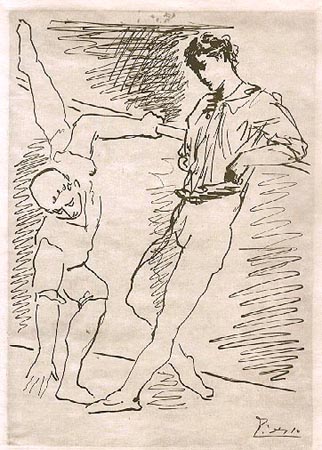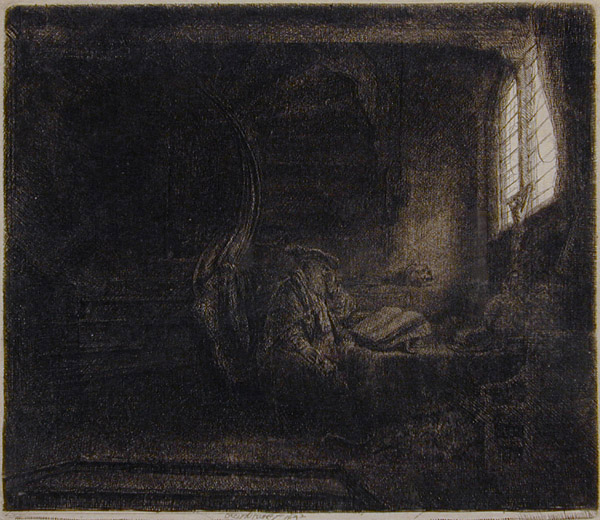This is an original signed Picasso copperplate etching. It’s one of many “Blue Chip” art pieces I sacrifice to bring people into an art auction. It makes no money for the charity, does nothing to help the finances, and must be replaced with something equally pricey for the next auction. It is strictly a “Loss Leader”, intended to attract an audience, and I’d frankly be happier without them, and I’ll tell you why:
First of all, nobody but an art dealer would know that these things are even for sale, and very few of them even have an inkling of what they’re worth, where to find them and how to authenticate them beyond doubt — you DON’T want returns.
Secondly, these things are bloody expensive. They’re BLUE CHIP, which is like betting on a horse after the race has been run. Most of the decent Blue Chips run around $35,000 wholesale, for something not too bad. At $150,000, you’re just starting to see serious pieces, when it comes to Rembrandts, and for Degas, the story behind the etchings is far more complex than even most art experts care to calculate and then try to educate their clients — a thankless and almost impossible task, believe me. Here’s a sample of my original Degas etchings — this one has an incredible story behind it:
I won’t tell the story here, but at an art auction in which I present this, I do tell the story. The problem is, when I risk selling this item, I lose an important part of the auction’s excitement and plotline — yes, there’s a plot, storyline, characters…these auctions are choreographed, timed and calculated to entertain, which is their best feature. It’s a fun way of raising money for charity, arguably far better than Bingo or Casino Night, and with the art auction, children can attend and learn a few fun facts about famous artists and art history in general.
The third reason I’d prefer not to have the Blue Chip artworks in the auction is that they’re SO incredibly hard to replace or to find good substitutions by the same artist. The whole point is that people are attracted by the Blue Chip Names — Rembrandt, Picasso, Miro, Chagall, Matisse, Dali — and without them, it’s a matter of record that far fewer people will come to an auction without Blue Chip names, even if they don’t ever buy them, which is all to the good, saves me having to find replacements.
Oh, don’t worry about seeing the same pieces over and over again — you won’t. I make sure to show new items for that auction audience next time and time after. This is an ongoing thing, not a one-shot, and I want to make sure the crowd is pleased, not just when they get the piece, but when they go to a framer or talk to an art expert and find out how well they did and what a wonderful piece of art is now in their home, office or den. You don’t get repeat customers unless you deliver the goods, and I take all pains to make sure what I offer at a charity art auction is as good as anything they’ll get at Sotheby’s or Christie’s, or even better, which occasionally happens.
Here’s an original Chagall from Daphnis & Chloe. It generally sells for anywhere from $2800 to $4500, depending on condition and other factors. Pencil-signed, it goes for many tens of thousands of dollars, but this is the same art, produced in the same way on the same day by the same person, except it didn’t come pencil signed, which comes to a difference of about $36,500. You could have this in a frame and put on a wall. It’s totally original, is exactly the same as the 75 pencil-signed pieces, but was bound-in to a book, and I have it, totally intact and beautiful.
Should you manage to score it for $2800, you can’t write off a penny of that as a donation, because you got a $2800 “value rebate” for your money, which to the IRS and to any art dealer, would be the same as $2800 in cash. Actually more, because that’s not the retail.
So there’s my fourth reason for not wanting these Blue Chips to actually sell at auction. Not only can’t I find a copy at the same price for which I’ve sold it, but I can’t find a copy at all…oh, wait, here’s one, still bound into the unbroken book, available on eBay for only $75,000, and then you have to ask yourself if you really want to destroy a book to get at a bunch of highly marketable bound-in originals. The answer, even from a Bibliophile like myself, must sometimes be “yes”. There’s no other way.
Speaking of Rembrandts, here’s one that I wish you’d show to any skeptical art expert. It’s not only an incredibly rich-toned and exceptionally deep-toned with remaining burr print, but it’s from a very famous collection — actually two famous collections, with one collector’s stamp on the back that’s worth the price just by itself. Provenance aside, it’s the very best Rembrandt I’ve ever owned at this price. What is the price? My price today would be $45,000, but you’d have to have an expert examine it and read the provenance before you saw what a bargain it was! It could actually bring even more, under the right circumstances. There isn’t a Rembrandt expert that would turn this piece down. It’s truly amazing, and hasn’t been on the market for over 30 years! I would happily ship this to a qualified expert for verification. Here are the details, the reasons that this piece is more than worth the mega-bucks:
REMBRANDT — St. Jerome in a Dark Chamber — Signed and dated Rembrandt f. 1642, Amsterdam. W/B 105 SECOND STATE — A fine, rich, very dark impression printed with tone on paper bearing the 7 Provinces watermark, thus proving it to be 2nd State and not later. Important Provenance, from the G.C. Freund Collection, Theodore Donson Collection (he is considered the world’s greatest expert on Rembrandt and wrote ALL the major books on Rembrandt etchings); reference: Lugt 953. A very important piece out of a very important collection, this is unusually fine and relatively early in the 2nd State run for this print; seldom seen this rich and fine, with all the details clear and sharp.
And that brings up the fifth reason I’d rather not sell Blue Chip art to uninitiated buyers. Once in a while, you run into a crooked art framer. What they’ll do is take your original artwork out, have it COLOR PRINTED on photopaper and then they’ll mount that in the frame and sell your original.
Couldn’t happen? Ask folks who have inherited Renoir etchings and lithographs, only to discover that the framer made the substitution in the distant past, because the practice existed as far back as photography could create an apparent double of a document, which is what a work on paper actually is, a signed or otherwise identified object, generally worth money — exactly how much money is a matter of time, place and market.
A coin was once worth its face value in the metal or other stuff in which it was struck or made; shell, stone, glass, bronze, copper, silver, gold. You carried your personal wealth in a little bag on your belt or around your neck in the form of necklaces.
You could think of an artwork on paper as a form of self-issued currency. Not all artists have a market, but some, including myself, do have a definite art market, blue-book and all. Gordon’s Print Service tracks every major print ever made and sold, and there are other markets. In fact, some prints are bought, sold & traded exactly like stocks and bonds, and here’s one of them:
It’s a pencil-signed Miro, “Aieule”, Man of 10,000 Ages. It’s large, beautifully framed in a wide black museum frame, and it’s for sale. How much? Lessee…. I’ve stored it for 35 years, framed it for around $300 by doing all the work myself…it’s a rare piece, hard to find…I’ll check to see if anyone else is offering it…hang on a minnit…boy, there’s a lot of reprinted junk on eBay, all purporting to be “original”…ah, “masterworks” has a number of similars, but not this piece, for sale, at anywhere from $25,000 to $35,000.
Somebody not familiar with these numbers in relation to works on paper by Blue Chip artists must be holding their head in pure pain. It’s beyond reason, yet these prices are low, in comparison to MOST of the fine art that’s out there. Without my method of locating affordable originals by great artists, there’s no chance. You’d have to pay in the hundreds of thousands or millions to obtain original artwork by the Blue Chips, but I’ve found a way to get hold of great ORIGINAL art by great artists, and I offer that in my charity auctions, making them unique and exciting.
One thing I can’t do with reason alone, and that’s to conquer sarcasm and cynicism. They’re not worth beating, because they tend to persist in the face of any rationality. I’m hoping that by posting some of the actual pieces I’m planning to offer that some experts will come forward and tell folks that this stuff is real and that it’s all right to own it.
As far as the prices are concerned, it’s a charity auction, not a free-for-all to grab fine art at slash-and-burn prices. You want to raise money for charity, right? With luck, the donors will NOT behave like the big bankers, lustfully gobbling up the fine art at bargain prices.
Every penny spent at the art auction below the fair market value of a piece will be deducted from your stated donation, by the IRS … believe it. So bargain prices will not be a feature of the fine art charity auction. You want to pay more than it’s worth, so you can write it off, right? In most charity auctions, that’d be easy. In mine, the BLUE CHIP art is so good that you’ll be hard-pressed to get above its market value. The other art is beautiful, but worthless on the art market, so the donations are very clearly a higher percentage of the sale, get it?
One more piece for good measure:
It’s an original Matisse Linoleum Cut, a gift from his daughter, Marguerite Dutuit, in 1981. It’s for sale for $4500, a fair price to be sure. Of course, it carries the monogram intaglio and the numeration, 30/100. Any questions?
See You At The Top!!!
gorby







